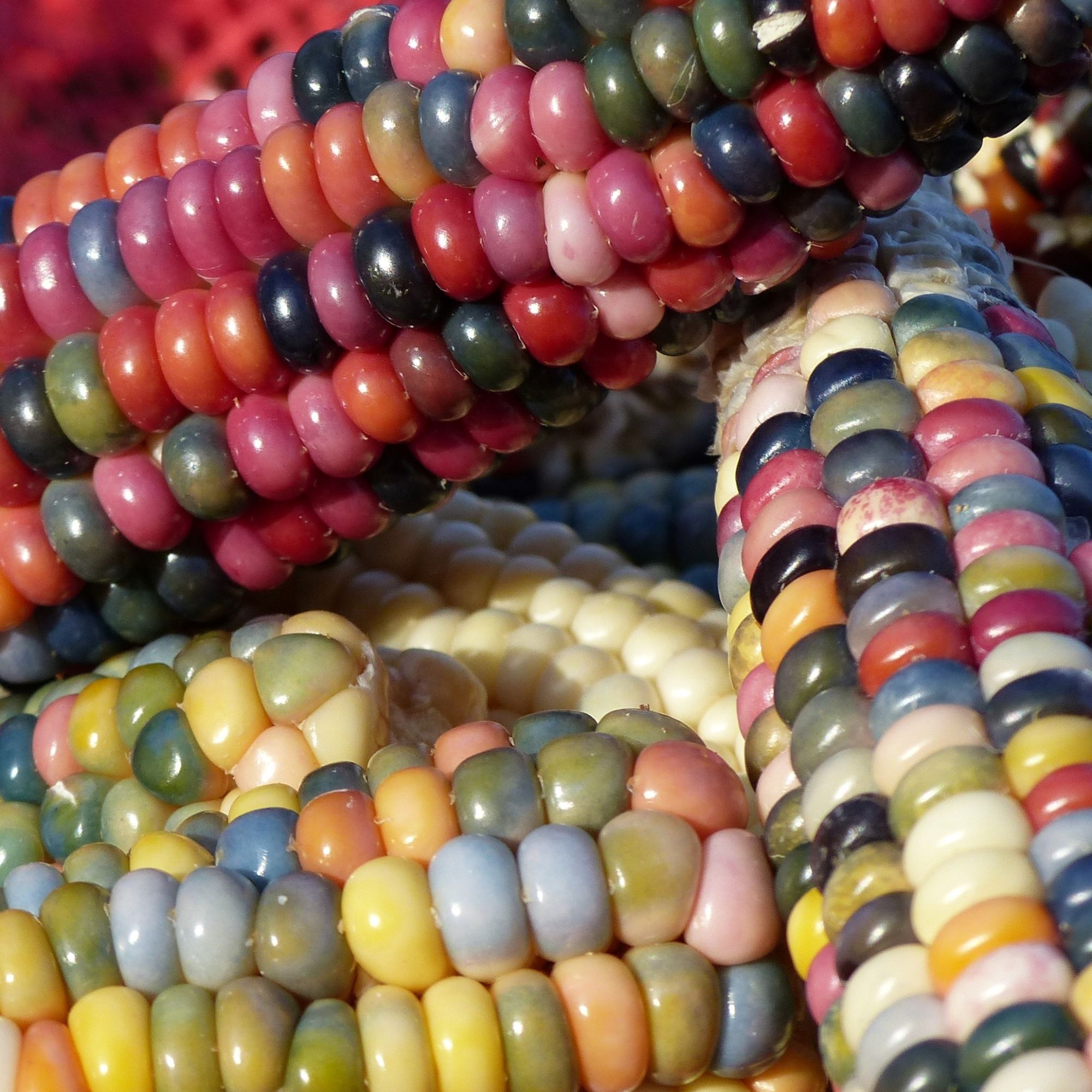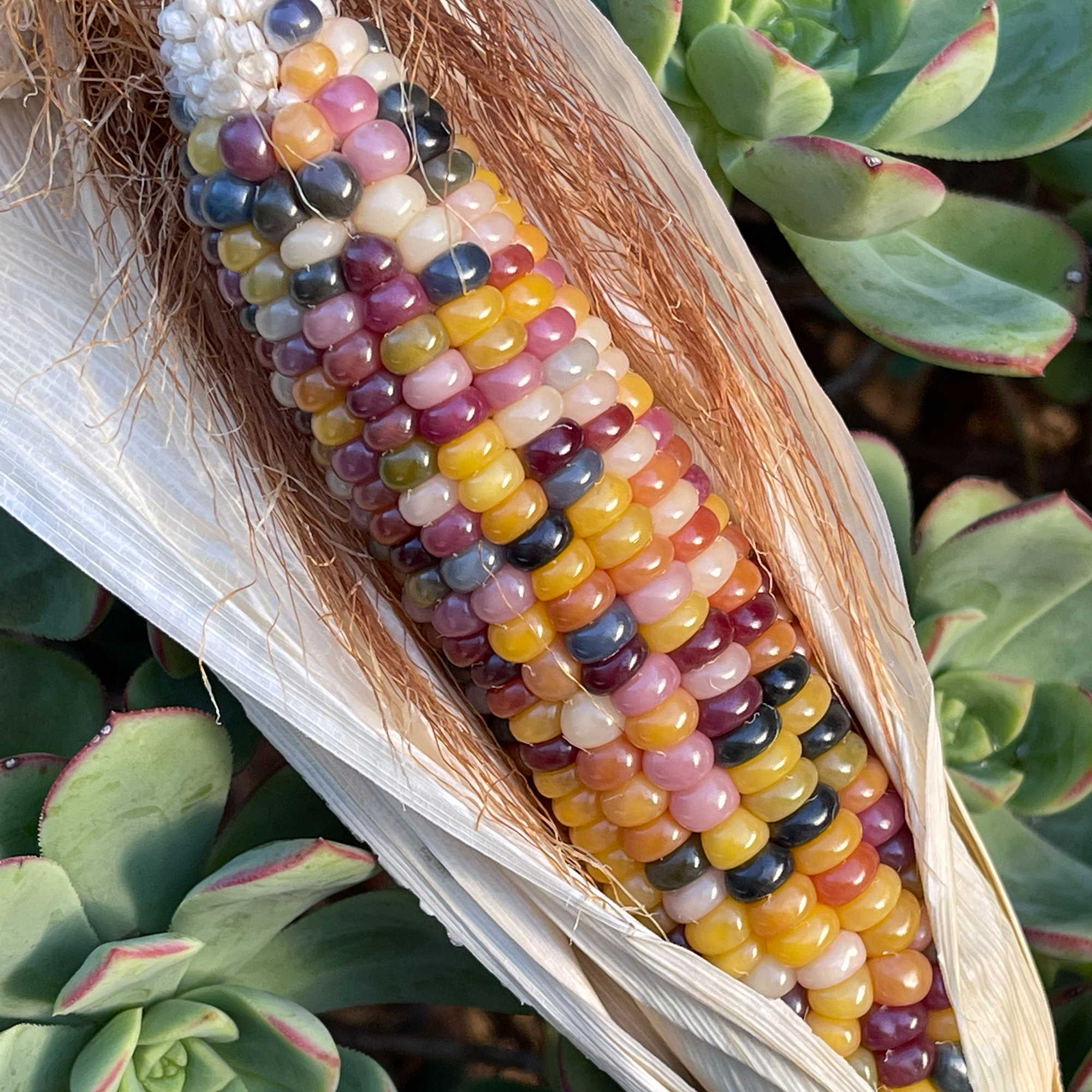
Vegetable gardens don't just have to be functional, they can be beautiful, too – especially if you plant yours full of glass gem corn.
One of our favourite edimentals, it's essentially a lesson in how to grow sweetcorn... with a rainbow-coloured twist. That's right; instead of the usual yellow and white kernels we know and love, glass gem corn has (as you'd likely expect from the name) husks filled to the brim with shining purple, pink, blue, red, and golden kernels that look like precious gems.
It's a lot of fun for anyone who's hoping to grow their own vegetables, and very easy to grow, too – although you'll need a fair bit of sunshine to make this one work, so it's best to skip it if you're working in a shady space.
How to grow glass gem corn

'Glass gem corn is the most colourful of all the corn, and is really quite amazing when harvested,' says Morris Hankinson, director of Hopes Grove Nurseries.
'Much like yellow corn, you can use its spectacular kernels to make popcorn – you’ll find it a lot of fun!'
Chomping at the bit to get started? Here's everything you should know...
What you'll need
If you're planning on growing glass gem corn at home, you'll need a similar shopping list to the one you've likely used for ordinary sweetcorn.
- Glass gem corn seeds, like the Sweetcorn (Popcorn) 'Fiesta' Seeds from Thompson & Morgan or Premier Seeds Direct's Corn Glass Gem Seeds from Amazon
- Small pots for seedlings (we really rate the Charles Dowding No Dig CD60 Long-Life Propagation Tray from Amazon)
- A good peat-free compost, such as Levington PEAT FREE Seed Compost (with added John Innes) from Amazon
- Something to keep hungry birds at bay, like this MAIYADUO Floristry Chicken Wire from Amazon
- Plant supports in the form of these LOIBUYZ Bamboo Canes from Amazon
Step-by-step guide
If you want to learn how to grow glass gem corn, we've got good news for you; it really is one of the easiest vegetables to grow.
With that in mind, then...
1. Time it correctly
'Glass gem corn can be sown anywhere between March to May depending on the weather conditions,' says Morris, who adds that 'you will need somewhere to keep them undercover until the weather warms up and all frost has passed.'
2. Sow your seeds
When it comes to sowing seeds for your glass gem corn crop, it's best to pop them in modules and keep them somewhere warm.
'I recommend doing this in April,' says Morris, who notes that the seedlings will thrive as well on a warm windowsill as they will in a greenhouse.

'Keep them moist, but not overwatered,' he adds.
3. Harden them off
Once you have a selection of sturdy corn seedlings, it's important to harden them off before your move them out into the great outdoors.
'You'll want to gradually acclimatise them to outdoor conditions over 7–10 days,' says Christopher O'Donoghue of Gardens Revived.
To do this with your glass gem corn, he advises you either pop them in a cold frame or, failing that, place them outside in a sheltered, shady spot.
'Do this for a few hours during the day, then bring them back inside at night,' continues Christopher. 'You'll want to gradually increase their outdoor time and exposure to sunlight, but avoid frost at all costs!'
After this period, your glass gem corn should be strong enough to plant outdoors in raised garden beds or a small vegetable garden.
4. Plant them out
We've said it before, and we'll say it again; it's best to think of corn as an ornamental grass when it comes to planting them successfully, as they're also wind pollinated plants.
'Planting in blocks will help pollination,' says Morris, 'and be sure to choose a sunny position, too.'
Prep the soil with well rotted organic matter, to ensure it's packed with all the nutrients your glass gem corn needs to thrive, and space each seedling about 45cm apart. Don't forget to give them a good watering to help them settle in!
5. Show them some love
It's a good idea to stake your plants to give them some much-needed support, and protect them from hungry birds with netting or chicken wire.
You'll also want to spend a fair bit of time weeding and mulching around your plants, not to mention watering them well during dry spells. And don't forget that corn is a nitrogen-loving plant, so it is important to apply something like Westland Fish, Blood and Bone All Purpose Plant Food from Amazon throughout the growing process.
6. Get harvesting
The best bit of this whole process? Harvesting your glass gem corn, obviously – which Morris says should take place sometime between July and October, depending on when you started your seeds off.
Wait for the husks to turn papery-brown and then twist them away from the stalk in a downward pulling motion.
FAQs
Is glass gem corn good to eat?
While sweetcorn can be eaten straight from the cob, the same isn't true of glass gem corn, which has much tougher kernels. As such, it's primarily used to make popcorn or cornmeal – although it's worth noting that a lot of people also grow glass gem corn for decorative purposes, drying the cobs out and using them in autumn wreaths and displays.
How do you know when glass gem corn is ready to pick?
Glass gem corn is ready to pick when the husks turn brown and dry out, and the kernels have fully developed their vibrant, glassy colours.
To ensure it's fully mature, it's a good idea to press a kernel with your fingernail; if it resists and feels hard, the corn is ready to harvest. You should also allow the ears to dry on the stalk as much as possible before harvesting for best results.
Now that you know how to grow glass gem corn like a pro, we fully expect you to have a vibrant autumnal display worthy of any harvest festival before too long. That or, y'know, the most exciting rainbow-coloured popcorn in town...







